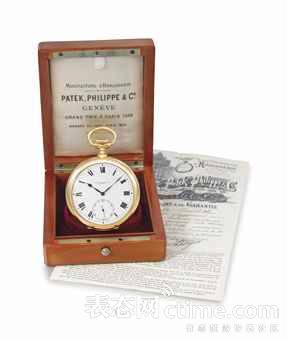175周年佳士得之lot28
6回复
PATEK PHILIPPE. AN EXTREMELY FINE, RARE AND LARGE 18K GOLD OPENFACE KEYLESS LEVER TOURBILLON WATCH WITH GUILLAUME BALANCE, ORIGINAL CERTIFICATE, BOX, BULLETIN D'OBSERVATOIRE AND KEW OBSERVATORY CERTIFICATE
SIGNED PATEK PHILIPPE & CIE., GENEVA, MOVEMENT NO. 174'562, CASE NO. 403'049, MOVEMENT MANUFACTURED IN 1916, FINISHED AND ENCASED IN 1917

Patek Philippe. An extremely fine, rare and large 18K gold openface keyless lever tourbillon watch with Guillaume balance, original certificate, box, Bulletin d'Observatoire and Kew Observatory certificate
Signed Patek Philippe & Cie., Geneva, movement no. 174'562, case no. 403'049, movement manufactured in 1916, finished and encased in 1917
Cal. 22''' nickel-finished Extra lever movement numbered twice, 18 jewels, Guillaume balance, bimetallic three arm one minute tourbillon carriage by Hector Golay, gold cuvette, white enamel dial, Roman numerals, outer railway minute divisions, subsidiary seconds, blued steel spade hands, large circular plain case, case, cuvette and movement signed and numbered, dial signed
60 mm. diam.
With Patek Philippe Certificate of Origin & Guarantee and original fitted wooden presentation box numbered 174'562. Furthermore delivered with the Extract from the Archives confirming production of the present tourbillon movement in 1916. It was finished with an enamel dial with Roman numerals and openface case in 1917 and sold on 15 November 1918. The Extract further states that the watch obtained an official chronometer rating certificate in 1916, first prize for a tourbillon balancier, and an observatory rating certificate and a second prize in Kew in 1917. Also delivered with copies of the Geneva Observatory timing sheet and results of the 1916 First Class timing contest where the watch obtained the 1st prize with 861 points and copies of the Kew Observatory Register of Watches Received - And Despatched - Abstracts of Results from September 1916. It was given the Kew reference 16894 and obtained a mention "especially good" in the Class A trial. In 1917, the watch was submitted again and was awarded a second prize.
The present high precision watch is amongst the most impressive and important tourbillon chronometers by Patek Philippe to appear in public in recent years. Its tourbillon carriage, one of the most difficult and costly horological complications to realize, was conceived by the celebrated watchmaker, inventor and engineer Hector Golay, then delivered to Patek Philippe in Geneva and finished by their highly skilled watchmakers.
In 1916, the watch participated at Geneva Observatory First Class timing contests where it was awarded a 1st prize. It was also submitted to the Astronomical Observatory of Kew and Teddington in Great Britain and obtained a Certificate A with mention "especially good" (see also Das Tourbillon by Reinhard Meis, p. 353) in 1916 and a second prize in 1917. Its movement had been prepared and adjusted by the gifted and prominent precision adjuster J. Golay-Audemars, one of Patek Philippe's best regulators of the time. Watches regulated by him consistently excelled at timing contests.
Offered here for the first time at public auction, this masterpiece combines all aspects requested by the demanding collector, one of the most discerning complications, the tourbillon regulator, the state-of-the art gold case of impressive size, presence of the original certificate and box, rating certificates from the world's foremost Observatories, the only such timepiece known with this highly historically important document, and last but not least its excellent, original overall condition.
For illustrations and descriptions of Hector Golay's tourbillon carriages also in Patek Philippe watches see Das Tourbillon by Reinhard Meis, pp. 45, 174, 175 & 179.
The Tourbillon
On 10 November 1801, horological legend Abraham Louis Breguet (1747-1823) received a patent for his ingenious tourbillon invention. Breguet designed the tourbillon (French for whirlwind) to compensate for fluctuations and errors in time measurement caused by the position a watch is placed in. For example, watches with traditional movements may keep excellent time when resting on a desk horizontally, but when that same watch is placed vertically in a pocket, gravity affects the frequency or rate of the escapement and thus its accuracy.
Breguet's invention compensated for these gravitational effects by placing the escapement in a revolving carriage. As the tourbillon carriage revolves (usually one entire revolution per minute), its position constantly changes and consequently the fluctuations in rate caused by gravity are averaged out. Once a tourbillon watch is properly adjusted, the effects of gravity are essentially nullified, regardless of how it is positioned.
Precision timekeeping has always been vital to the scientific community, and in 1873, the first annual chronometer competition was held at the Geneva Astronomical Observatory. Rigorous quantitative internationally recognized testing standards were established. The testing, which initially lasted for 40 days, consisted of placing the watches in various positions and temperature conditions. The prestigious watchmakers Patek Philippe were awarded First Prize in the competition as early as 1884.


